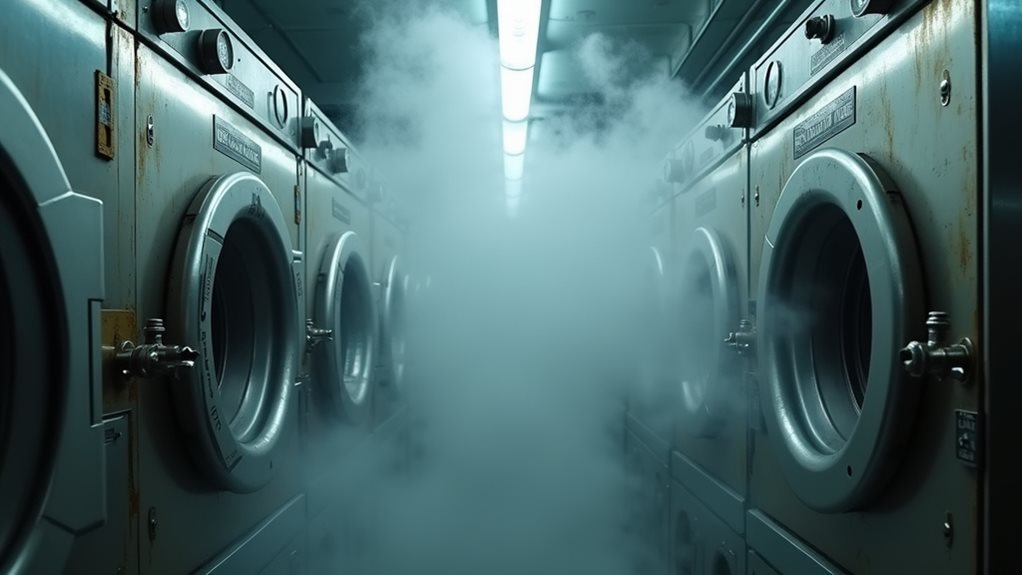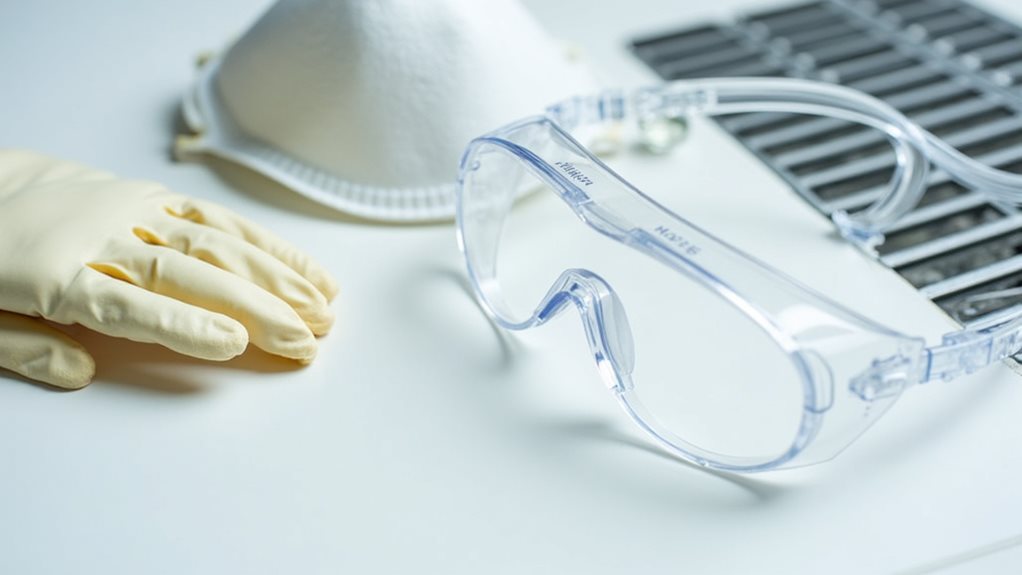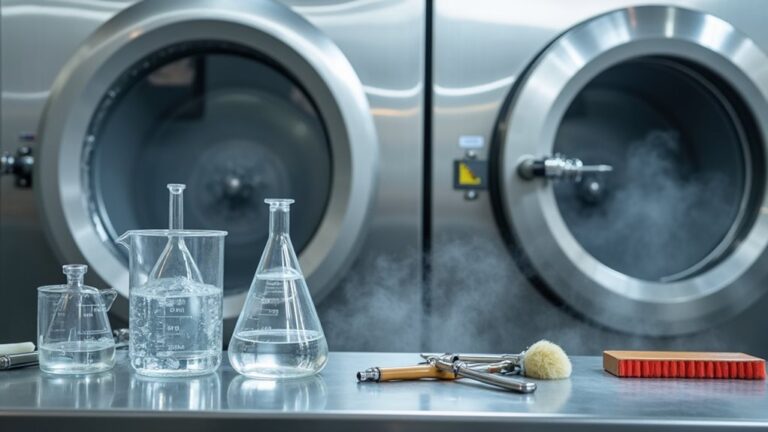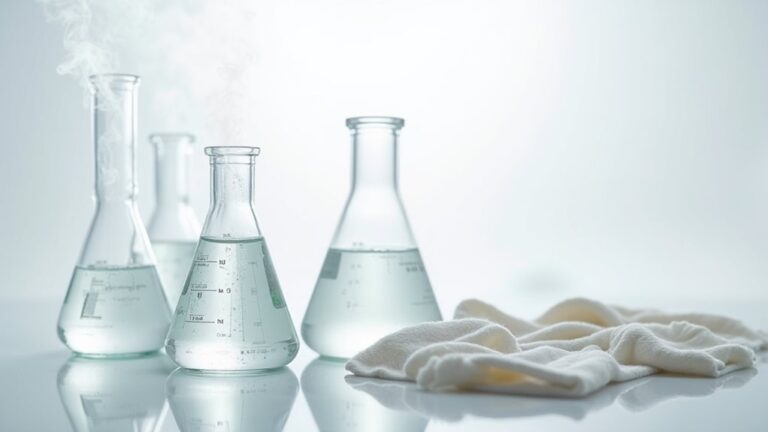Yes, dry cleaning fumes are genuinely dangerous to your health, and I learned this the hard way after years of grabbing freshly cleaned suits without thinking twice. Those chemical vapors you’re smelling contain PERC, a known carcinogen that can cause immediate headaches, dizziness, and breathing problems, while long-term exposure increases your risk of bladder cancer and lymphoma—especially concerning if you’re pregnant or have children at home, since their faster breathing rates concentrate these toxins more intensely, though thankfully there are safer alternatives and protective steps that’ll keep your family healthier.
What Makes Dry Cleaning Fumes Hazardous to Your Health
The invisible threat lurking in your freshly cleaned clothes might surprise you, but those crisp garments hanging in your closet could be quietly releasing toxic fumes that pose real dangers to your health.
Your supposedly clean clothes may be silently poisoning the air in your home with dangerous chemical vapors.
PERC, the chemical solvent most cleaners use, doesn’t just vanish after cleaning—it clings to fabric fibers like an unwelcome houseguest who overstays their welcome.
When you breathe these fumes, you’re exposing yourself to immediate health effects including dizziness, headaches, and respiratory irritation.
Even more concerning, long-term exposure links to serious cancers like bladder cancer and non-Hodgkin lymphoma.
Dry cleaning workers face the highest risks due to constant workplace exposure, which is why many facilities are adapting to environmentally friendly alternatives that protect both employees and customers. 🌿
To minimize exposure risks, always allow dry cleaned items to air out before wearing them, especially garments that will be worn close to your skin or by children and pregnant women.
Understanding PERC and Its Cancer-Causing Properties

Among all the chemicals used in dry cleaning, PERC stands out as the most concerning villain in this story, and understanding exactly why it’s so dangerous will help you make better decisions about protecting your family’s health.
Perchloroethylene (PERC) isn’t just another dry cleaning chemical—it’s officially classified as a human carcinogen by the U.S. National Toxicology Program, which means scientists have enough evidence to confirm it causes cancer in people.
The health risks are genuinely alarming: chronic exposure links to non-Hodgkin lymphoma and multiple myeloma, while even short-term contact can trigger dizziness, headaches, and breathing problems.
What’s particularly unsettling is how PERC lingers on your freshly cleaned clothes, creating ongoing exposure every time you wear them. 🤢
Beyond personal health risks, PERC contamination spreads far beyond the dry cleaning facility, polluting air, water, and soil in surrounding communities.
How Chemical Residues Accumulate on Your Clothing

When you drop off your favorite wool blazer at the dry cleaner, you’re probably not thinking about how those harsh chemicals will literally embed themselves into the fabric fibers, but that’s exactly what happens with every single cleaning cycle.
Every time you dry clean that blazer, harsh chemicals are literally embedding themselves deep into the fabric fibers.
PERC doesn’t just clean your clothes and disappear—it actually soaks into materials like wool, cotton, and polyester, creating a reservoir of chemical residues that stick around long after you’ve picked up your garments.
Georgetown University found that wool retains about half its PERC concentration even after a week, and here’s the kicker: repeated dry cleaning sessions make this buildup worse.
These accumulated chemicals slowly vaporize from your clothing, creating potential health risks in your closet and bedroom. 🧥
This is particularly concerning since the EPA has classified PERC as a probable human carcinogen, linking it to serious health issues including neurological problems and liver damage.
Vulnerable Populations at Higher Risk From Exposure

If you’re pregnant or have little ones at home, you’ll want to pay extra attention to dry cleaning fumes because their developing bodies process chemicals differently than yours does.
I learned this the hard way when my pregnant sister mentioned feeling dizzy after picking up her work clothes, and her doctor explained how those tiny systems can’t filter toxins as effectively as adult bodies can.
Your children’s faster breathing rates and smaller size mean they’re fundamentally getting a more concentrated dose of whatever’s floating in that chemical-scented air, making them particularly vulnerable to both immediate reactions and long-term health concerns.
While workers in dry cleaning facilities face the highest exposure levels, even brief contact with freshly cleaned garments can trigger respiratory irritation in sensitive individuals.
Children’s Heightened Chemical Sensitivity
Because their tiny bodies are still developing at lightning speed, children face considerably higher risks from dry cleaning chemical exposure than adults do.
Think of it this way – when you’re renovating a house, you wouldn’t expose the foundation to harsh elements, right? That’s fundamentally what happens when children breathe in perchloroethylene (PERC) and other solvents from freshly dry-cleaned clothes.
Their rapidly growing organs and faster metabolic rates mean they absorb these chemicals more efficiently than we do, which honestly isn’t the kind of efficiency any parent wants.
This chemical exposure can trigger respiratory issues and potentially contribute to developmental disorders down the road.
I’ve learned that even brief exposure matters more for kids, so always air out dry-cleaned items before bringing them into your child’s space.
Consider choosing certified green cleaners that use eco-friendly alternatives like wet cleaning or biodegradable solvents to eliminate these risks entirely.
Pregnancy and Exposure Risks
Just as children’s developing bodies make them vulnerable, pregnancy creates another window of heightened risk that honestly caught me off guard when I first learned about it during my sister’s second trimester.
When you’re expecting, your body becomes incredibly sensitive to chemical exposure, and perchloroethylene (PERC) poses particular concerns for both you and your developing baby.
Research links PERC exposure during pregnancy to developmental issues and potential fetal harm – something that made my sister immediately rethink her dry cleaning habits.
The adverse effects aren’t worth the risk of crisp clothing, trust me. If you must use dry cleaned items during pregnancy, air them out thoroughly before bringing them inside, or better yet, find alternative cleaning methods until after delivery.
Many dry cleaning facilities are now switching to safer alternatives like liquid CO2 and hydrocarbon solvents to reduce health risks for their customers and workers.
Safer Alternative Cleaning Methods and Solvents

While traditional dry cleaning has dominated the garment care industry for decades, you’ll be relieved to know that innovative alternatives are transforming how we can safely clean our cherished clothes without exposing ourselves to harmful chemical fumes.
These safer alternative cleaning methods include wet cleaning, which uses mild detergents and computer controls to effectively clean fabrics without perchloroethylene (PERC).
Liquid carbon dioxide cleaning offers another eco-friendly option that’s non-toxic and biodegradable, removing dirt without hazardous chemicals.
Some cleaners now use liquid silicone (D5), which won’t damage fabric colors while staying completely safe.
Even hydrocarbon solvents, though carrying some cancer risks, are considerably safer than PERC.
Consumer demand is driving this positive shift toward healthier practices.
These non-aqueous solvents remain highly effective at dissolving oils, grease, and stubborn stains that traditional water-based washing simply cannot remove.
Protective Steps to Minimize Chemical Exposure

You can dramatically reduce your exposure to harmful dry cleaning chemicals by taking a few simple, proactive steps that I’ve learned through years of watching my grandmother carefully handle her weekly dry cleaning hauls.
The key areas you’ll want to focus on include storing your freshly cleaned garments properly, handling them with awareness and care, and guaranteeing adequate ventilation throughout the entire process.
These protective measures might seem minor, but they’re your best defense against those nasty chemical fumes that can cause headaches, dizziness, and other unwanted symptoms 🛡️.
Beyond respiratory concerns, these same chemicals can trigger contact dermatitis and skin rashes when clothing retains chemical residues, making proper handling even more critical for your overall health.
Proper Clothing Storage Methods
After bringing home that freshly dry cleaned blazer, I learned the hard way that tossing it straight into my bedroom closet wasn’t the smartest move—within hours, my entire room smelled like a chemical factory, and I woke up with a pounding headache that felt like I’d been breathing paint fumes all night.
Now I store my dry cleaned clothes in areas with proper ventilation systems, keeping them far from bedrooms and living spaces where perchloroethylene (PERC) vapors can concentrate.
I’ve switched to breathable garment bags instead of plastic ones, and I always air out items outside first.
When possible, I choose green dry cleaning options that use safer alternatives to traditional solvents.
Fortunately, garments typically retain only trace amounts of chemicals after proper dry cleaning, making the risk to consumers relatively low compared to occupational exposure.
Safe Handling Practices
Since that eye-opening experience with my blazer turned my bedroom into a chemical nightmare, I’ve developed a whole arsenal of protective habits that have saved me from countless headaches—literally and figuratively.
First, I limit my time inside dry cleaning establishments, especially those stuffy ones where perchloroethylene (perc) fumes hang thick in the air like invisible fog. When I pick up my garments, I ask the staff to open windows or doors for better ventilation—most are surprisingly accommodating!
My safe handling practices include immediately washing my hands after touching freshly cleaned items, then airing everything outside for at least an hour before bringing clothes indoors.
Additionally, I’ve started seeking out cleaners that offer safer alternatives like wet cleaning or biodegradable solvents, which significantly reduce my exposure to harmful chemicals.
These simple steps have transformed my relationship with dry cleaners use from anxiety-inducing to manageable.
Ventilation and Airing
When I learned that proper ventilation could be the difference between breathing safely and turning my lungs into a chemical processing plant, I became absolutely obsessed with airflow—and honestly, it’s probably saved my respiratory system more times than I can count.
Here’s my tried-and-true ventilation strategy for dealing with perchloroethylene (PERC) and other nasty chemicals:
- Open everything – Crack windows and prop doors wide when you’re in the dry cleaning shop to boost air circulation.
- Air out your clothes – Hang freshly cleaned garments outside for at least an hour before bringing them indoors.
- Run fans or air purifiers – These workhorses dramatically improve your indoor air quality by clearing lingering fumes.
Trust me, your lungs will thank you for taking these simple steps! 🫁




